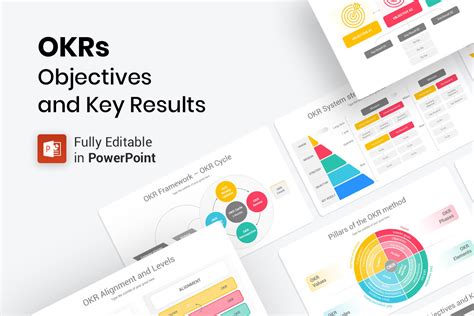The world of goal-setting and strategy implementation has seen a significant shift with the advent of OKRs (Objectives and Key Results). This powerful framework, popularized by John Doerr in his book "Measure What Matters," has been widely adopted by organizations and individuals seeking to achieve focused and measurable objectives. If you're looking to implement OKRs within your team or organization but are unsure where to start, a free OKR PPT template can be a great resource. Here, we'll delve into the world of OKRs, explain why you might need a template, and provide insights on how to use one effectively.
What are OKRs?
OKRs are a goal-setting methodology that helps individuals and teams define and track objectives and their measurable outcomes. The system consists of two main parts:
-
Objectives: These are the specific goals you want to achieve. Objectives should be inspirational, yet concrete, and should answer the question of where you want to go.
-
Key Results: These are the measurable milestones that show progress toward achieving the objectives. Key results should be specific, time-bound, and measurable, answering the question of how you will achieve the objectives.
Why Use OKRs?
OKRs are beneficial for several reasons:
- Focus: They help teams focus on what really matters, ensuring everyone is working towards the same objectives.
- Alignment: OKRs align teams and departments around common goals, fostering a sense of unity and shared purpose.
- Tracking Progress: The measurable aspect of OKRs makes it easier to track progress and adjust strategies as needed.
- Motivation: By setting ambitious yet achievable goals, OKRs can boost motivation and engagement among team members.
Why Do You Need an OKR Template?
An OKR template can be incredibly useful for several reasons:
- Simplifies the Process: It simplifies the process of setting up and organizing your OKRs by providing a structured format.
- Ensures Consistency: Templates ensure that your OKRs are consistent in format and structure, making it easier to review and compare progress across different teams or projects.
- Reduces Time: It saves time by providing a ready-made structure that you can fill in with your objectives and key results.
- Improves Communication: A well-designed template can also improve communication among team members by clearly outlining the objectives and key results.
Features of a Good OKR Template
When looking for an OKR template, consider the following features:
- Simple and Clear Structure: It should have a clear and simple structure that makes it easy to understand and fill out.
- Customizable: The ability to customize the template according to your specific needs can be very beneficial.
- Alignment with OKR Principles: It should align with the core principles of OKRs, ensuring that your objectives are inspirational and your key results are measurable.
- Space for Notes or Comments: Additional space for notes or comments can be useful for explaining certain objectives or key results in more detail.
How to Use an OKR Template Effectively
Using an OKR template effectively involves several steps:
- Define Your Objectives: Start by defining your objectives. Ensure they are inspirational, yet concrete.
- Determine Your Key Results: For each objective, determine the key results that will indicate progress toward achieving the objective.
- Set Targets: Set specific targets for each key result, making sure they are measurable and time-bound.
- Regularly Review and Adjust: Regularly review your progress against your OKRs and adjust your strategies as necessary.
Tips for Success
- Keep it Simple: Don’t overload your OKRs with too many objectives or key results. Focus on what's truly important.
- Make it Ambitious: Set ambitious objectives that challenge your team, but make sure they are still achievable.
- Review Regularly: Regular review sessions are crucial for adjusting strategies and ensuring everyone is on track.
Conclusion
Implementing OKRs can significantly improve your team's focus, alignment, and overall performance. A free OKR PPT template can be a valuable resource in this journey, providing a structured format for setting and tracking your objectives and key results. By understanding the principles of OKRs and using a template effectively, you can unlock the full potential of this goal-setting methodology.

Gallery of OKR Templates






What is the primary purpose of using OKRs?
+The primary purpose of using OKRs is to define and track objectives and their measurable outcomes, ensuring teams focus on what really matters and work towards common goals.
How often should I review my OKRs?
+It's recommended to review your OKRs regularly, ideally on a quarterly basis, to assess progress, adjust strategies, and ensure everyone remains aligned and focused on the objectives.
Can I use OKRs for personal goal-setting?
+Yes, OKRs can be effectively used for personal goal-setting. The framework helps individuals set ambitious yet achievable goals and track their progress in a structured manner.
